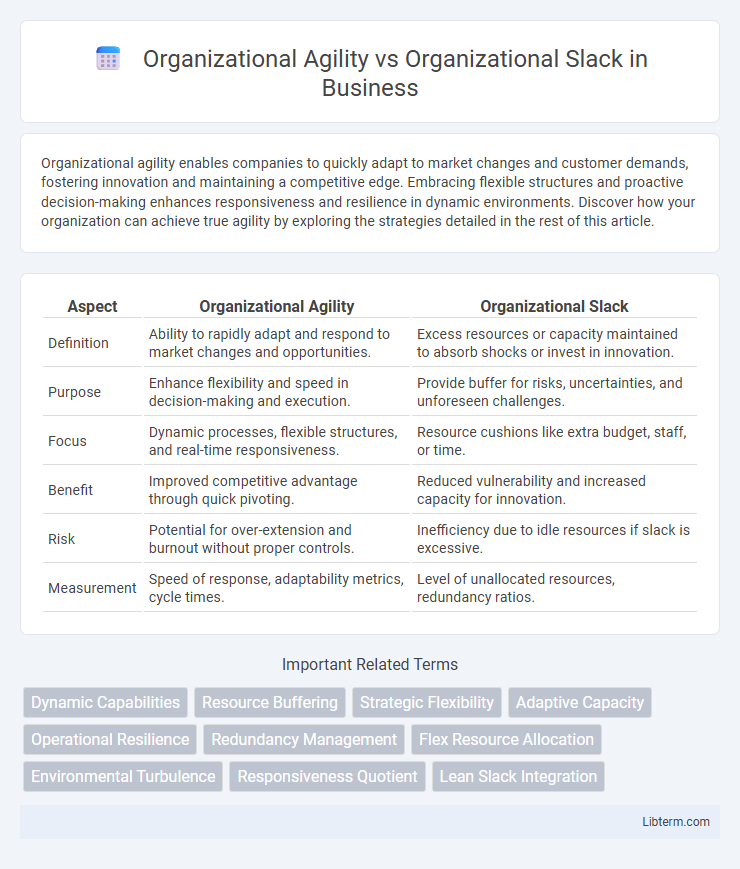Organizational agility enables companies to quickly adapt to market changes and customer demands, fostering innovation and maintaining a competitive edge. Embracing flexible structures and proactive decision-making enhances responsiveness and resilience in dynamic environments. Discover how your organization can achieve true agility by exploring the strategies detailed in the rest of this article.
Table of Comparison
| Aspect | Organizational Agility | Organizational Slack |
|---|---|---|
| Definition | Ability to rapidly adapt and respond to market changes and opportunities. | Excess resources or capacity maintained to absorb shocks or invest in innovation. |
| Purpose | Enhance flexibility and speed in decision-making and execution. | Provide buffer for risks, uncertainties, and unforeseen challenges. |
| Focus | Dynamic processes, flexible structures, and real-time responsiveness. | Resource cushions like extra budget, staff, or time. |
| Benefit | Improved competitive advantage through quick pivoting. | Reduced vulnerability and increased capacity for innovation. |
| Risk | Potential for over-extension and burnout without proper controls. | Inefficiency due to idle resources if slack is excessive. |
| Measurement | Speed of response, adaptability metrics, cycle times. | Level of unallocated resources, redundancy ratios. |
Introduction to Organizational Agility and Organizational Slack
Organizational agility refers to a company's ability to rapidly adapt to market changes and emerging opportunities through flexible processes, innovative culture, and responsive decision-making. Organizational slack represents excess resources--such as financial reserves, personnel, or time--that can be mobilized to absorb shocks or invest in new initiatives, providing stability during uncertainty. Balancing agility with sufficient organizational slack enables firms to remain competitive while maintaining resilience in dynamic business environments.
Defining Organizational Agility
Organizational agility refers to a company's ability to rapidly sense and respond to market changes, customer demands, and emerging opportunities through flexible processes, adaptive strategies, and empowered teams. This capability enhances competitive advantage by enabling swift decision-making and innovation in dynamic environments. Unlike organizational slack, which involves maintaining excess resources as a buffer, agility emphasizes responsiveness and real-time adjustment without relying on resource surplus.
Understanding Organizational Slack
Organizational slack refers to the cushion of excess resources, such as time, capital, or personnel, that enables a company to absorb shocks and pursue innovation without immediate pressure. Understanding organizational slack is crucial for managing flexibility, as it balances resource availability against efficiency, allowing firms to respond swiftly to market changes while maintaining operational stability. Effective slack management supports long-term adaptability by providing the necessary buffer for experimentation and strategic shifts.
Key Differences Between Agility and Slack
Organizational agility emphasizes rapid responsiveness and flexibility in adapting to market changes, while organizational slack refers to the reserve resources that provide a buffer for uncertainty. Agility prioritizes speed, innovation, and dynamic capabilities, whereas slack focuses on maintaining excess capacity or resources to absorb shocks. The key difference lies in agility proactively driving change, whereas slack acts as a passive safety net for stability.
Advantages of Organizational Agility
Organizational agility enhances a company's ability to rapidly adapt to market changes, fostering innovation and maintaining competitive advantage. This dynamic capability reduces response time to customer needs and enables efficient resource reallocation, maximizing operational effectiveness. Compared to organizational slack, agility drives proactive decision-making and continuous improvement, supporting sustainable growth in volatile environments.
Benefits and Risks of Organizational Slack
Organizational slack provides a cushion of resources that enhances a company's flexibility, enabling swift adaptation to market changes and encouraging innovation by allowing experimentation without immediate pressure. However, excessive slack can lead to inefficiencies, resource wastage, and complacency, potentially slowing decision-making processes and reducing competitive responsiveness. Balancing slack with agility ensures resilience, promoting sustainable growth while mitigating risks of underperformance and stagnant organizational culture.
Impact on Innovation and Adaptability
Organizational agility enhances innovation and adaptability by enabling rapid decision-making, flexible structures, and responsiveness to market changes. In contrast, organizational slack provides a buffer of resources and time that fosters experimentation and risk-taking, supporting sustained innovation during periods of uncertainty. Balancing agility and slack allows firms to innovate efficiently while maintaining resilience against disruptions.
Balancing Agility with Slack for Optimal Performance
Balancing organizational agility with slack is crucial for optimal performance, as agility drives rapid adaptation to market changes while slack provides necessary resources and buffers for innovation and risk management. Excessive agility without slack can lead to burnout and operational fragility, whereas too much slack may result in inefficiency and slow decision-making. Effective organizations strategically allocate slack to enhance flexibility, enabling swift responses while maintaining stability and long-term resilience.
Case Studies: Agility vs. Slack in Action
Case studies of organizational agility versus slack reveal that companies like Amazon leverage agility to rapidly innovate and respond to market changes, significantly enhancing competitive advantage. In contrast, firms like Toyota exemplify organizational slack by maintaining buffer resources that enable sustained operational stability during demand fluctuations. These real-world examples highlight how agility fosters dynamic adaptation, whereas slack provides resilience and risk mitigation within corporate strategies.
Strategies for Enhancing Agility Without Excess Slack
Enhancing organizational agility without accumulating excess slack requires implementing lean resource management, emphasizing flexible decision-making processes, and cultivating a culture of continuous learning and rapid responsiveness. Strategies involve deploying adaptive technologies, cross-functional teams, and real-time data analytics to optimize operational efficiency while avoiding resource underutilization. Aligning strategic goals with dynamic market demands ensures agility is maintained through optimized resource allocation rather than redundant capacity.
Organizational Agility Infographic

 libterm.com
libterm.com